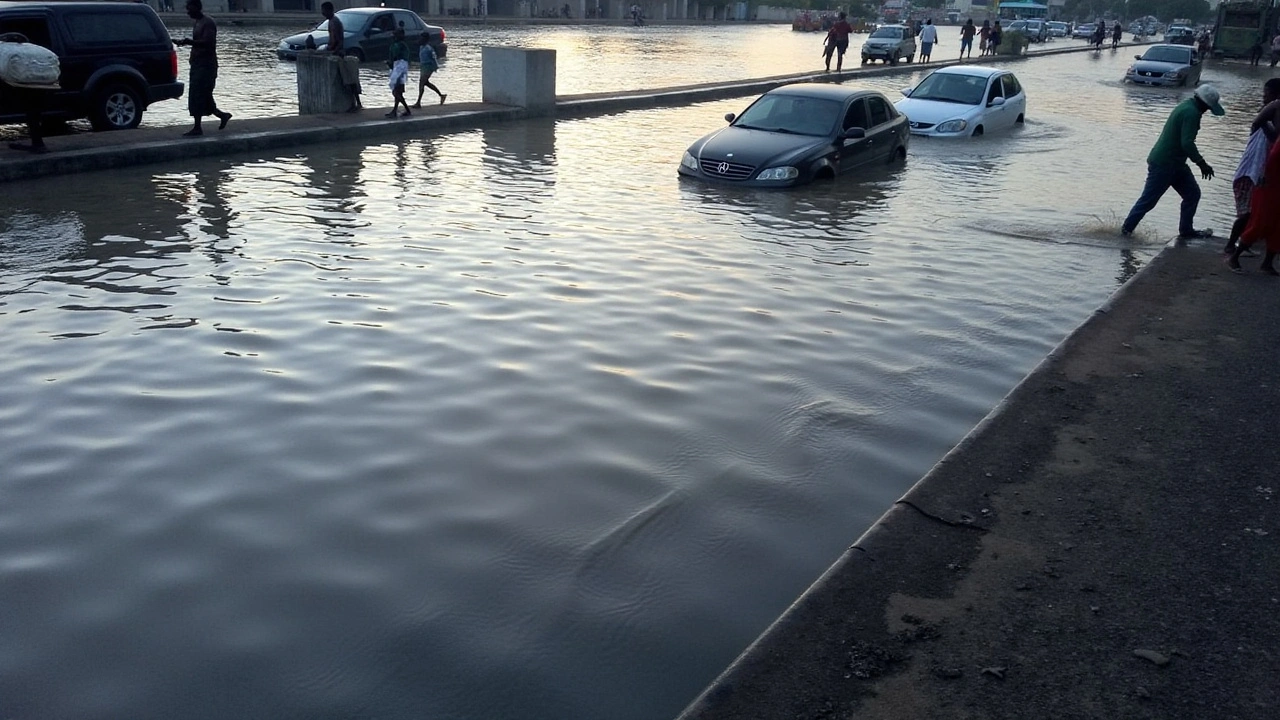Maiduguri Faces Worst Flooding in Decades
Maiduguri, the bustling capital city of Borno State in Nigeria, is currently grappling with what is considered its worst flood in thirty years. The catastrophic flooding was triggered by the overflow of the Alau Dam, a key infrastructure overwhelmed by intense rains over the past week. The overflow has broken another channel in the dam, causing unprecedented devastation that has submerged scores of homes and farmlands, leaving the community in disarray.
Authorities in Maiduguri have acted swiftly in response to the disaster. The Commissioner for Information and Internal Security, Prof. Usman Tar, released a statement titled "Flooding Alert for River Bank Residents," highlighting the urgent need for immediate evacuation. The communique underlined the importance of residents following designated evacuation routes to ensure their safety. Despite the alert, the flooding has left hundreds of families without shelter, forcing many to camp outdoors under harsh conditions, trying desperately to salvage their belongings from the rising waters.
The flooding has entirely inundated neighborhoods along the riverbanks. Consequently, residents find themselves cut off from their homes, with no clear idea of when they might return. The crisis in Maiduguri is not an isolated incident—it is part of a larger pattern of flash floods that have been wreaking havoc across northern Nigeria. The National Emergency Management Agency (NEMA) has painted a dismal picture, noting that recent floods have devastated approximately 16,488 hectares of farmland across 27 states. Moreover, over 32,000 houses have been destroyed, impacting the lives of about 227,000 people.
Exorbitant Human and Economic Costs
The human and economic toll of these floods is monumental. Hundreds of families in Maiduguri now find themselves at the mercy of the elements, scrambling for basic necessities such as food, clean water, and medical supplies. Children and the elderly are particularly vulnerable, and makeshift shelters along the roads have become a common sight. Local humanitarian groups and management agencies are working round the clock, but the scale of the disaster is daunting.
Prof. Usman Tar’s declaration is not only a call to action for immediate evacuation but also highlights the broader issue of climate resilience in Nigeria. Although floods are not an uncommon occurrence during the rainy season, the severity and frequency of these recent events suggest a worrying trend. According to the Minister of State for Agriculture and Food Security, Sen. Abdullahi Sabi Aliyu, up to 51% of Nigeria’s farming areas are susceptible to flooding in 2024. This poses a direct threat to the country’s food security, potentially diminishing this year’s anticipated harvest by a significant margin.
In response to the crisis, the Nigerian government is attempting to alleviate some of the disaster's impacts. The Minister of Finance and Coordinating Minister of the Economy, Wale Edun, has proposed a relief fund of N3 billion to be allocated among states affected by the floods. This gesture aims to provide some immediate relief, although the path to full recovery remains uncertain.
International Aid and Long-Term Strategies
The flooding in Maiduguri and across northern Nigeria has also caught the attention of international agencies. The United States, through the U.S. Agency for International Development (USAID), has committed over $6.5 million to support humanitarian efforts. This funding will chiefly support local partners, such as the International Organization for Migration (IOM), which are on the ground addressing the severe flooding across the country. These international efforts are expected to provide crucial relief supplies and services, ranging from emergency shelter to logistical support.
However, solving the immediate crisis is only one part of the equation. Long-term strategies that address the root causes of such disasters are critically needed. Climate experts have pointed out that increasing urbanization, poor land management, and inadequate infrastructure are exacerbating the impact of natural disasters. Investments in sustainable infrastructure, better water management systems, and urban planning reforms are vital to build resilience against future floods.
Public awareness campaigns are also necessary to inform and educate communities about the risks they face and the measures they can take to protect themselves. Local governments, in collaboration with NGOs and international agencies, must focus not only on immediate relief but also on preventive measures to mitigate future risks. The recent floods have highlighted the urgency of adopting comprehensive policies that integrate eco-friendly strategies and community-based initiatives.
As Maiduguri and other affected regions slowly begin the recovery process, the mood is a mixture of resilience and uncertainty. The specter of more severe weather events looms large, but so does the resolve to build back better. Collaboration between local communities, government bodies, and international organizations will be crucial in this effort, ensuring that when the rains come again, Nigeria is better prepared to withstand their impact.

Building Resilience for the Future
Recent events have demonstrated the critical need for a more robust disaster management framework in Nigeria. The government must prioritize investments in flood defenses, early-warning systems, and comprehensive community preparedness programs. Additionally, there's an increasing need for sustainable farming practices that can withstand and adapt to changing climatic patterns.
On the ground, residents are calling for more transparent and proactive communication from authorities. Timely information can mean the difference between life and death, and local leaders need to ensure that all residents, including those in remote areas, receive adequate warnings and have clear evacuation plans. Schools, community centers, and religious institutions can play a pivotal role in disseminating this information and providing temporary sanctuaries during crises.
Moreover, rebuilding efforts must take into consideration the lessons learned from this disaster. Homes and infrastructure in flood-prone areas should be constructed or retrofitted to be more resilient to water damage. Efforts should also be made to restore natural barriers such as wetlands and forests, which play a crucial role in flood mitigation. As international aid continues to pour in, it is essential that these funds are used judiciously and transparently, focusing on long-term resilience rather than mere short-term relief.
Maiduguri and the wider region are at a crossroads. The path they choose now will determine how well they can protect their people and their livelihoods from future disasters. It's a call to action for everyone involved—not just the government and international agencies, but also the communities themselves. By working together, it is possible to build a future where such tragedies are less frequent and far less devastating.
In conclusion, the flooding in Maiduguri serves as a stark reminder of the vulnerability that many regions face in an era of changing climate patterns. The immediate response has been commendable, but the real test lies in the long-term strategies that will be employed to prevent a recurrence. The resilience and adaptability of communities, combined with comprehensive planning and international support, will be key to overcoming this challenge and ensuring that the people of Maiduguri and other affected areas can rebuild their lives with hope and security.
